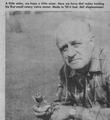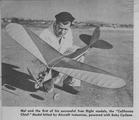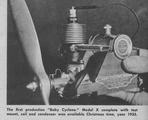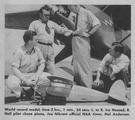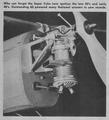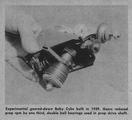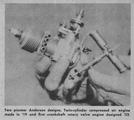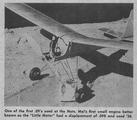PIONEERS ... Mel Anderson
Model Airplane News. September, 1960
While he did not create the first model gas engine, he has contributed substantially to its present high state of design development, performance and efficiency. Mel Anderson a modeling great and one of the pioneers of Model Aviation; whose experience dates back to before the First World War and who has been active in modelling right up until recently. A man, who has contrihl1ted greatly to the development of model engines as we know them today. Model engines of his design are still in production today.
Mel designed and built the first crankshaft-rotary valve model motor. He made the first twin-engine gas model. He held two World's records, and he had much to do with the "Baby Cyclone" motor, the first production rotary-valve model engine. He designed the "Super Cyclone", the best by far of the prewar 60's, and he built the Anderson "Spitfire"-probably the finest big engine made. He is responsible for the "Baby Spitfire", one of the first lhA motors. Yet, with all these achievements, Mel Anderson's name is all but unknown to today's generation of model builders.
Nowadays we have things quite easy-engine of excellent quality priced as low as $3.95, and completely finished ready-to-fly models are found in any hobby shop. Even model kits have reached the stage where hardly any patience and little skill is necessary to complete an attractive and fine-performing model. But this did not come about by itself! Years of thought, hard work, and painstaking experiment on the part of the "Early Birds" of modelling were required before the model-building hobby reached today's level of perfection, and the earliest of these "Early Birds" was Mel Anderson.
The first time that Mel saw an airplane was not too long after the Wright brothers had made their first flights. Mel had come to California in 1908, at the time when the first airplanes were beginning to rise into the skies of Southern California. Many were the great names in Aviation that Mel watched fly their primitive craft: Glenn Martin, Glenn Curtiss, Lincoln Beachy the incomparable stunt flier, Cal Rodgers the first to fly from Coast to Coast.
In those days flying was a tremendous adventure; every flight a triumph of the ingenuity and courage of man over the implacable force of gravity. A pilot sat in his frail wood, wire, and fabric contraption, completely exposed to the airstream, not even strapped to his seat! Little was known of aerodynamics. Motors were balky and unreliable, stability was almost non-existent, parachutes had not yet been invented. No wonder that, with his cap on backwards and his motorcycle goggles, the Birdman of the 1900's was regarded as the bravest of the brave and worshipped by every American boy. Young Mel Anderson was no exception! Even today he recalls the thrill of watching those early Giants of Aviation as if it were only weeks instead of years in the past.
The first model airplanes that Mel saw were at a "Kite Meet" held in Los Angeles in 1911. Even at this early date, the models were marvels of craftsmanship. Some were stick-type rubber jobs of very thin solid hardwood; others were beautifully made scale models of Wright Gliders, Bleriot Monoplanes, and Curtiss Pushers-made from bamboo and wire and covered with silk. Balsa was unknown then, and the models were heavy and inefficient, but they flew! A 5-second flight was average and the winner of the meet only stayed aloft about IS seconds, but they FLEW!
Young Mel was inspired. He built many models-from redwood and shingles, bamboo and cambric, spruce and wire and silk. But none of them would fly. He didn't know enough about it! The factors of lift and drag, thrust and weight were unknowns to Mel-there were no books or magazines to turn to for help and no kits to buy; but he kept trying, and by 1915 he was finally able to make his first really successful model. It would stay up for over 30 seconds under its own power!
Mel built his first model motor in 1919. It was powered by air stored under pressure in a tank carried in the model. Mel made this motor from brass fishing rod ferrules, brass tubing, and steel drill rod and assembled it with soft solder. It is a real landmark in Model' Aviation-because it used a rotary valve in the shaft to control the flow of air to its twin cylinders. It was this same principle that Mel later used in his gas motors.
After World War I, Aviation fell into disrepute, and Model Aviation along with it. The achievements of the pilots in the war had largely gone unnoticed in America, the public attention being taken by the Doughboy; and the Submarine Menace and the Marines at BelJeau Wood. It was not until years after the Armistice that the feats of the "Warbirds" were publicized. The post� war barnstormers with their reckless flying did not make a favorable impression, and people were forced to the conclusion that Aviation was a harum-scarum proposition that no right-thinking person would have anything to do with. And this went double for model airplanes! A boy of the '20's who indulged in such a foolish fad as "toy aeroplanes" was letting himself in for nothing but ridicule from his friends and family! Along with many other "Junior Birdmen", young Mel soon had enough of this treatment. He drifted away from models toward the more manly pursuits of motorcycle racing, speedboats, and hopping up Model T Fords.
But in 1925, Mel got a job in Aviation! He went to work for Douglas-hut his career here was short, due to the well meant advice of a friend. This man, who was in a position to know, said, "Mel, get out of this crazy business. There's no future in it, it's only a fad. Quit while you can and get a job where you can have something to look forward to!"
Silly as this advice may seem today, it was actually the way the picture appeared at the time, and except for one incident, Mel's friend's prophecy could well have come true. But one morning in May of 1927 a young man sat down in a seat at Roosevelt Field, New York and some 33 hours later arose from that seat at Le Bourget Field in Paris, France--and the world went wild. Charles Lindbergh had wiped the tarnished escutcheon of Aviation so bright that people were blinded by its glitter!
Gone was the derision for the aviator. Even the model aviator was forgiven, and model airplane dubs formed and flourished; contests were held; model magazines were published-and Model Aviation was here to stay!
The stigma removed, Mel Anderson returned to modelling, and his thoughts turned to a new challenge--a gas-powered model! He started by making what was essentially a miniature motorcycle engine; a 3-port job about 1.00 cu. in. displacement, with movable points and a two throat, two-speed carburetor. The spark plug was made by AC; it was one of a number of miniature plugs made as watch chain ornaments for an advertising stunt! Mel used these plugs in many of I)is motors and they worked as well as if they had been specifically designed for the job.
He made several 3-port engines, each an improvement over the last, but he was not satisfied. He wanted to build a model engine that was really simple, strong, and reliable, and that put out real power I And one day in 1932 the memory of that soldered-together compressed-air motor with the rotary valve that he made in 1919 came back-and Mel began the design of an entirely new kind of model airplane engine, one with a rotary intake' valve. Completed, this motor was unlike anything ever seen before. It had a bore and stroke of ;~" (.525 cu. in.), with an updraft intake and the first true needle valve. It was made from aluminum castings for which he had made his own patterns, and it ran beautifully right from the start.
Mel of course built models to fly with his engines. He had little trouble with them-partly because of his experience with rubber ships and partly because of the great size of these early gas models. A typical example had a span of 8 feet, was 66 in. long, and weighed almost 7 Ibs. Mel's first engines did not produce a great amount of power judged by today's standards-5000 rpm on a 16" prop was quite respectable in those days. And so his models Hew much like real airplanes of the same period.
Having made his first rotary-valve engine and flown it, Mel was happy-but not yet satisfied. He knew he could do better! His next engine was much smaller and a lot more powerful. It had a displacement of .363 and it was a real beauty. It looks modern even today, but in 1933 it was revolutionary. It had a one-piece case, updraft intake, movable points, and a swept-back exhaust. It ran like a charm and was the best-performing motor that Mel had yet built. It would turn a 16" prop up to 7,000 rpml
In 1933, Mel became acquainted with Bill Atwood, an accomplished model flier and an expert with indoor models. He had done some experimenting with model engines himself, and Mel's new "Midget" really aroused his interest. Bill set to work and soon had a similar motor finished -only a little like Mel's, although the same size; and it ran nicely. Bill made a model for it and flew it-and one day a great idea struck him.
Mel had never even considered the possibility of manufacturing a model engine for sale to others. To him, his model motors were just a hobby. But Bill Atwood could see into the future! And he began to search for a man with both the vision and the money to back him in the manufacture of a model motor-that anyone could buy at his local hobby shop I Bill found such a man in 1935: Major C. C. Moseley, president of Grand Central Air Terminal, Los Angeles' largest airport. Bill told the Major what he had; let him see it run; flew his model for him. The Major was a far-seeing man too, and it wasn't long before Bill came to Mel and said, "Mel, I'm in the model airplane engine business! Come on down and get in on the fun!" And that is how the fabulous "Baby Cyclone" was born.
The first "Baby Cykes" were built and placed on sale around Christmas-time of 1935. It had a displacement of .363 and was made from 1935 until 1939, during which more than 15,000 were sold. There were 7 different models of this motor: models '"'X", "A", "'B", "C", "D", "E", and "F". Each version was an improvement over the last, but the basic design was never changed. It was somewhat primitive judged by today's standards, but in its day it was the finest engine on the market. The "Baby Cyke" could fly a model as well as or better than any .60 of the same period.
But one day in 1939 the Major came to Mel-Bill Atwood had left the company some time before to start his own model engine business-and said, "Mel, I think the "Baby Cyke" has seen its day. I know you've got a lot of good ideas, so I'd like you to design us a brand new motor the best you know how to make!"
And Mel started to work-and that is how the incredible "Super Cyclone" was begun. Mel made up 12 different experimental engines, with innumerable modifications to each, before he was satisfied. He had come up with the absolute ultimate in performance and reliability, and not only that-the engine was beautiful! In fact, at the end of 1940, all records for the .60 class engine were held by the "Super Cyke".
Another record that the "Super Cyclone" broke was the sales record of the "Baby Cyclone". Over 50,000 "Super Cykes" were sold! But then came the attack on Pearl Harbor and production of model motors was halted by order of the government.
However, it was permitted to make engines from parts already on hand, and fortunately Mel had plenty, so he was able to keep turning out "Cyclones" for a few more months. And during this time something happened that showed just how highly regarded the "Cyke" was. Many servicemen were modelers, of course, and hundreds of thousands of them were stationed in California. So a good bit of traffic developed between the various camps and the "Cyke" plant by servicemen in search of motors and parts-the most notable of which was a regular trip via B-17 from March Field to Grand Central Terminal-sometimes piloted by the C.O. of March himself!
But good things cannot last forever. Soon the "Cyclone" parts were gone and the plant closed. Mel got a job in war industry, but his heart was still with the model engine, and he spent many hours in designing and experimenting-improving on the already near-perfect "Super Cyke". When VJ day came, Mel had a decision to make: should he go back with the Major and make more "Cykes", or strike off on his own as Bill Atwood had done, and produce the engine he had been dreaming of during the war? In the end, Mel decided to try it on his own.
Mel put all his energy and enthusiasm into the plans for his new motor. It was to be the most wonderful engine ever made--brand new, with only one criterion to be applied: supreme quality! This was the incomparable Anderson "Spitfire". But Mel guessed wrong! Oh, the engine itself was everything that he had wanted to make it-but by now a trend had developed and Mel had been too busy to get out with the modelers and see for himself what was happening. The modelers were drifting away from the big engines! The .60's once king of the flying fields, were rapidly giving way to their smaller brothers, the .29's and .19's. And so the Anderson "Spitfire", acme of model engine perfection -turned out to be a "white elephant".
Many "Spitfires" were made and sold -but not quite enough to keep the company going. Mel wasn't sure just what to do about it. The only thing he was sure of was that modelers were buying small engines instead� of large ones. So Mel stopped and took a look around. He saw that in Europe the diesel motor was king; and since there was no ignition system required by this type of engine, it could be made in very small sizes. But the American market had already received some American diesels, and they were not popular.
And then Ray Arden came out with his Glow Plug-and that gave Mel a real idea! The .29 s were ruining the sales of the .60's because they were smaller and flew easier-to-build models? All right! Mel would build a small engine! It would be smaller than a .29; or a .19; or an .09! Mel's idea for the 1/2A motor was on its way.
Work was begun on the new baby Mel threw himself into the project just as he had with his previous engines. He kept in mind the lessons he had learned during the war when mass production was really mass production. He got set to produce his new "Baby Spitfire' in quantity, but with every bit of quality that he knew. He was well on his way to finishing up his tooling, when a bombshell burst. K&B had beaten him to the punch!
Lud Kading and Johnny Brodbeck had had the same idea as Mel at about the same time; but they were able to get their "Infant" motor on the market first. Mel was momentarily dismayed, but it didn't take him long to recover. Maybe the "Infant" wasn't too much of a threat to the "Baby Spitfire" after all; it was an .020 while the "Baby Spit" was an .045, over twice as big. Maybe they wouldn't compete with one another-after all, .29's and .60's don't fly in the same class. Why worry?
Then OK came out with their "Cub" .049.
Here was a case of three manufacturers all coming up with the same idea at the same time-and they were all right. there was plenty of business for all and everyone benefited. When Mel's "Baby Spitfire" hit the dealers' shelves it was an immediate success, as were the "Infant" and the "Cub" as well. Over half a million "Baby Spitfires" were sold, and nearly as many of its later successors, the "Spitzy" .045i the "Royal Spitfire" .065, and the "Royal Baby Spitfire" .049.
These last four engines were the climax of Mel Anderson's career in the Model Industry, for they were the last motors he' produced bet ore leaving the model business. Mel finally decided to disregard the advice his well-meaning friend had given him in 1925, because he is now at work in the full-scale aircraft field. He is a production engineer for a manufacturer of high precision components for both airplanes and missiles. Mel's background in model engines has suited him ideally for this position. He has no degree, but his wealth of practical experience-gained the hard way-enables him to be of tremendous help with the problems plaguing aircraft engineers today. Mel may not be his name, but most of us will agree that he has every right to sign his name: Mel Anderson, B.C., S.C., A.S., B.S.—for "Baby Cyclone", "Super Cyclone", Anderson "Spitfire", and "Baby Spitfire", of course!
This page designed to look best when using anything but IE!
Please submit all questions and comments to
[email protected]
